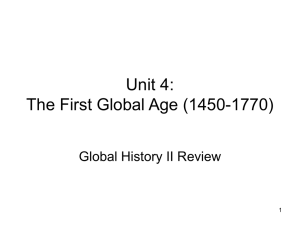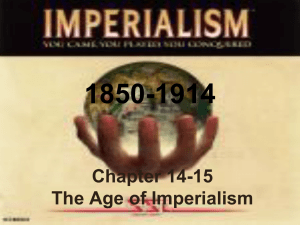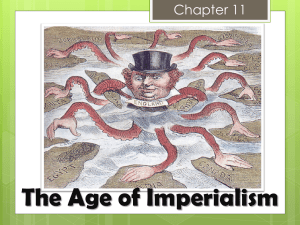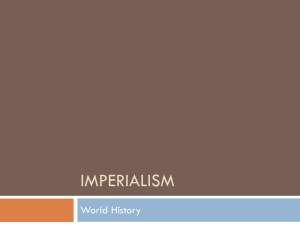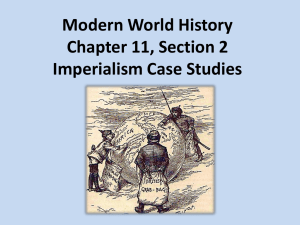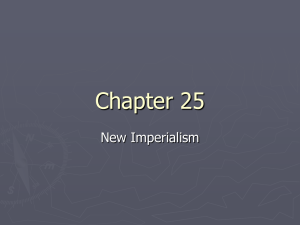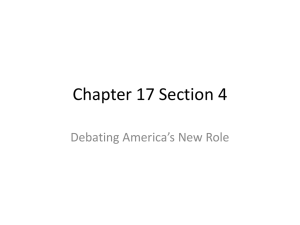Ch.11 The Age of Imperialism
advertisement
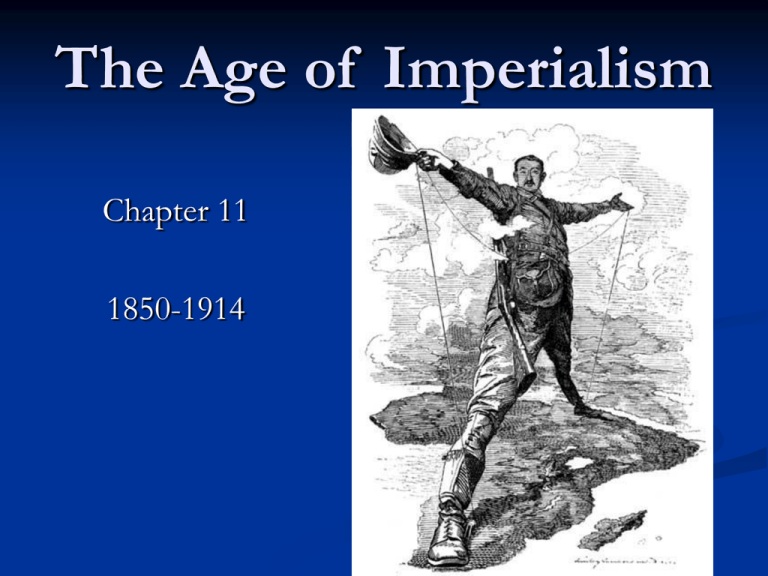
The Age of Imperialism Chapter 11 1850-1914 What is imperialism? The seizure (takeover) of a country or territory by a stronger country What is Imperialism? Why do Europeans do this? Industrialization sparks the need for: Land perfect for establishing trading and military posts Natural resources and raw materials New markets for products What is Imperialism? Europeans want to control all aspects of their colonies Politics Society Economy Culture and customs Types of Imperialism Methods of Management Direct Control Paternalism – Europeans provide for local people but grant no rights Assimilation – adaptation of local people to ruling culture Indirect Control Limited self-rule for local governments Legislative body includes colonial & local officials Types of Imperialism Forms of Control Colony Protectorate Governs itself, but under outside control Sphere of Influence Governed by a foreign power Outside power controls investments & trading Economic Imperialism Private business interests assert control I. The Scramble for Africa Africa Before European Dominion Divided into hundreds of ethnic groups Followed traditional beliefs, Islam or Christianity Nations ranged from large empires to independent villages Africans controlled their own trade networks Europeans only had contact on African coasts The Scramble for Africa (cont) Nations compete for overseas empires Europeans wanted more land Contained large amounts of gold, diamonds, and rubber Africa was a mystery to many Europeans who penetrated Africa were: Explorers – seeking wealth and notoriety Missionaries – trying to convert Africans to Christianity Humanitarians – “westernize” the “savages” The Scramble for Africa (cont) Forces Driving Imperialism Belief in European superiority Racism Social Darwinism Factors Promoting Imperialism in Africa European technological superiority Europeans had means to control New medicines prevent diseases The Division of Africa The Berlin Conference (1884) Europeans leaders divide Africa No African ruler invited Little or no thought about the complex differences in ethnic groups By 1914 – Only independent nations Liberia Ethiopia According to this cartoon, which European countries were fighting for a position in Africa? How did the Berlin Conference lead to the situation shown in the cartoon? South Africa Three Groups Clash for Power Africans Boers Zulu nation, led by Shaka, fought the British Zulu nation lost to British in 1887 Dutch settlers that had controlled South Africa since the mid 1600s Also known as Afrikaners British Gained control of South Africa after the Berlin Conference Boer War Fought between the Boers and the British Many Africans fought with the Boers First example of “total war” British win in 1910 Established the Union of South Africa (British Rule) Effects of European Imperialism in Africa II. Case Study: Nigeria Britain’s control of Nigeria Britain takes control by diplomacy & force Nigeria very culturally diverse All of Nigeria claimed as a colony in 1914 250 ethnic groups British utilize indirect rule Local chiefs resent limits on their rule African Resistance Africans Confront Imperialism Unsuccessful Movements Broad resistance, but Europeans have superior weapons Algeria fights the French for 50 years German East Africa resistance results in 75,000 deaths Successful Movements Ethiopia under Emperor Menelik II Plays Europeans against each other Stockpiles modern weapons Defeats Italy and remains independent Legacy of Imperialism Negative Effects Africans lose land and independence Many lives are lost Traditional cultures breakdown Division of Africa creates problems that continue today Positive Effects Reduces local fighting Sanitation improves Hospitals and schools created Technology brings economic growth III. Europeans Claim Muslim Lands The Ottoman Empire Loses Power Empire begins to decline in 1566 Death of Suleyman I Modernization movements are unsuccessful Greece and Serbia gain independence European Powers look to gain Ottoman lands Downfall of the Ottoman Empire Crimean War (1853) Crimean War – Russia vs. Ottoman Empire Russia seeks Ottoman land Access to a warm-water port Russia loses war Ottomans are shown to be weak Russia still is able to take land Europeans Grab Territory England gains control of: India – natural resources Suez Canal – international trade Persia – oil and tobacco Russia gains control of: Persia – oil, tobacco, & access to Indian Ocean Afghanistan – oil The Suez Canal IV. British Imperialism in India British Expand Control over India East India Company Controls India thru economic imperialism Company uses an army including Indian soldiers known as “sepoys” India was seen as the most important colony Due to its production of raw materials Known as the “Jewel in the Crown” Effects of British Rule Impact of Colonialism Railroads move cash crops and goods faster British control political and economic power Cash crops resulted in loss of self-sufficiency and caused famine Indian culture is disrupted due to racism and missionaries Britain sought to “modernize” India The Sepoy Rebellion Indians Rebel Sepoys refuse to use cartridges due to religious reasons They had to bite them open – greased with pork fat Considered unclean by Muslims Many sepoys were jailed, others rebelled British put down the rebellion Results Britain takes direct control of India Increased distrust between Indians and British Nationalism in India Call for reforms India adopts modernization movements Many Indians adopt western ways Religious Issues Remain Formation of the Indian National Congress (1885) Called for independence from Britain Formation of the Muslim League (1906) Many Muslims did not trust Hindus within India Imperialism in Southeast Asia European Powers Invade the “Pacific Rim” Lands of Southeast Asia that border the Pacific Ocean Britain – Malaysia, Burmia, and Singapore Netherlands – Indonesia France – Indochina (Vietnam, Laos, Cambodia) Why? Land perfect for establishing trading and military posts Excellent for plantation agriculture Imperialism in Southeast Asia Results Modernization helps the European businesses Education, health, and sanitation improves Millions migrate to find work Racial and religious clashes increase England’s Empire Grows V. Imperialism in China and Japan China vs. The West China was self-sufficient – no need for trade China kept a favorable balance of trade Europeans were able to shift the balance Sale of Opium – addictive drug from poppy plant Opium War (1839-1842)– China vs. Britain China loses – signs Treaty of Nanjing Extraterritoriality – foreigners were not subject to Chinese laws Chinese power over the West ends China vs. The West Foreign Influence Grows Growing Spheres of Influence A Surge in Chinese Nationalism Boxer Rebellion Poor peasants and workers who resented foreign priviledge Beginnings of Reform China tried to become more western Further added to internal problems Imperialism in China Imperialism in Japan Japan remained isolated from western world for centuries – only traded mainly with China Treaty of Kanagawa (1854) – ends Japan’s isolation Meiji Reform – Japan begins to modernize beginning in 1867 Japan was competitive with the west in many modern industries Imperialism in Japan Russo-Japanese War (1904) Treaty of Portsmouth Japan gained Russian territory Russia forced out of Korea Japan Controls Korea Takes control of the peninsula in 1910 Begins a period of extreme oppression THE END
